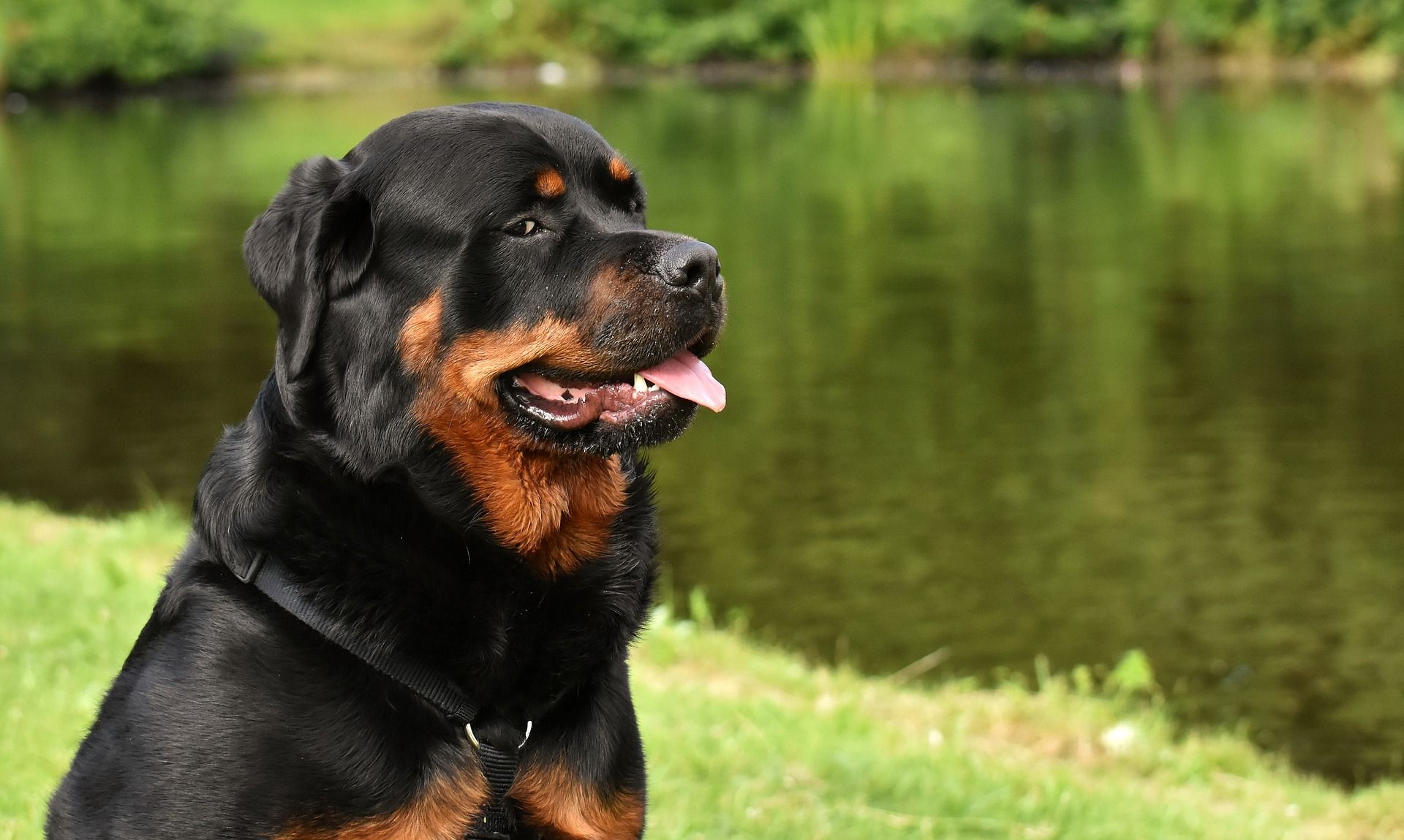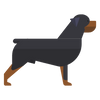Average Lifespan of a Rottweiler + How to Get More Time

Whether you already own a Rottweiler or are considering getting in contact with a breeder, you may be wondering how long your furry friend will be with you. Every breed is different, and even males and females of the same breed can differ in their life expectancy. Therefore, this article is dedicated to giving you all the information you need to learn about the lifespan of your Rottweiler.
The average lifespan of a Rottweiler is between 8-10 years. However, this differs between males and females. The average lifespan of a male is 8.7 years, while female Rottweilers tend to live longer, with an average of 9.5 years. The longest living Rottweiler lived to just over 13 years old.
I will dive into the details around a Rottweiler's life expectancy, including why they seem to have a shorter lifespan than other dogs and the oldest recorded Rottweiler. You will also find factors that play a role in reducing their lifespan so you can be prepared to give your Rottie the longest life possible.
Please note, some of the links on this site are affiliate links which help support the running of this site at no additional cost to you.
Average Lifespan of a Rottweiler
Rottweiler's have one of the shortest lifespans of all dog breeds, ranging between 8-10 years. As a reference, the longest-living dog breed is the Chihuahua, which can live up to 18 years. The shortest-living dog breed is the Bernese Mountain Dog, living an average of 5-7 years.
As with most breeds, males and females differ slightly when it comes to life expectancy. The life expectancy of each is listed below.
- Male Rottweiler: 8.7 years
- Female Rottweiler: 9.5 years
In general, you will find that larger dogs tend to have shorter lifespans than smaller dogs. There are many theories as to why this might be, none have been proven to be the exact cause. Below are some of the theories.
- A faster growth rate puts strain on their bodies, leading to more degenerative diseases (cancer, arthritis, hip dysplasia, etc.)
- A faster growth rate equates to a faster rate of ageing.
- Larger dogs are used more as working dogs, putting them at higher risk of injury and death than smaller dogs.
Unfortunately, one cause of death that is lowering the average lifespan of a Rottweiler is aggression. Rottweilers are still used today for intimidation, where they are left, or even encouraged, to be aggressive. This is devastating with the knowledge of how beautiful a Rottweilers temperament actually is.
Another consideration is how we raise our Rottweilers. Generally, in the animal kingdom, larger animals live longer. However, among domesticated dogs, larger animals have shorter lifespans. It is also interesting to note that the average lifespan of a wolf is 14 years, and their growth is just as rapid as a Rottweiler.
On that note, you will find ways you can extend the life of your Rottweiler further down in this article. But before we get there, below is the ageing progression of a Rottweiler.
Puppy: 0-2 Years
While Rottweilers reach their maximum height around one year old, they do not reach their full body weight until approximately two years of growth. Some larger Rottweilers will even need three years to fill out completely.
This explains why a 1-year-old Rottie looks tall but is still lanky. Just like most teenagers! In this puppy stage, it is important to provide your Rottweiler with the correct nutrition, exercise and training so their fundamental development is as healthy as possible.
Adult: 2-7.5 Years
Adult Rottweilers are those that have reached their full height and weight, which usually occurs around 2-years old. However, the size of an adult Rottweiler depends on whether they are male or female. Below are the average sizes of each.
- Males: 110 lbs and 24-27 inches at the withers
- Females: 92 lbs and 22-25 inches at the withers
By the time your Rottweiler is an adult, you should be in a well-established routine. Just keep in mind that you will need to adjust his/her nutrition and exercise to accomodate a fully grown body.
Senior: 7.5+ Years
Rottweilers begin to slow down around 7.5 years of age. Technically, a 'senior' Rottweiler is defined as one that is showing signs of ageing, such as greying hair, slowing down on walks, difficulty standing, etc.
Once again, you will need to consider the food and nutritional requirements of your older Rottweiler. For example, they may need more fibre to keep their toileting regular. They also may not need to eat or walk as much.
Oldest Recorded Rottweiler: Champ
Exceptionally old Rottweilers are those that live beyond 13 years. This is the magic number that scientists get excited about. 13 years to a Rottweiler is equivalent to a human living beyond 100 years old.
The oldest documented Rottweiler was Champ, who lived to approximately 15.5 years old. To live to almost double his life expectancy was an incredible effort.
Increasing the Lifespan of Your Rottweiler
Why Do Rottweilers Have a Short Lifespan?
As I mentioned earlier, there are many theories as to why Rottweilers, and other large dogs, have short lifespans. The leading causes of death in a Rottweiler are listed below, taken from a 2017 study.
- Cancer (33%)
- Inability to stand (16%)
- Disorders associated with a mass (7.1%)
- Gastro-intestinal disorders (6.1%)
- Brain disorders (4.2%)
- Undesirable behaviour with subsequent euthanasia (4.2%)
- Musculoskeletal disorder (3.8%)
- Lower respiratory tract disorder (3.2%)
- Spinal cord disorder (2.9%)
- Vertebral arthropathy (2.6%)
- Other (12.8%)
Many of these may seem familiar. That's because most of these are issues that humans experience in their older age as well. But you might be pleased to hear that there are ways you can help prevent these illnesses in your Rottweiler.
Diet
Diet plays a huge role in your Rottweiler's health. In particular, overfeeding a Rottweiler can lead to obesity, which increases the likelihood of death. However, underfeeding can also reduce their lifespan.
Research demonstrates that approximately 7% of Rottweilers die from being overweight or underweight, but also that 16% die from an inability to stand. It is well-known that obesity can lead to rapid degeneration of joints and therefore an inability to stand.
For your reference, you can find the average weight for Rottweilers above.
Another dietary consideration is the nutritional content of the food that you feed your Rottweiler. Feeding your Rottweiler too many 'fillers' may reach their daily caloric intake goals, but may not give them the nutrition they need to live a long and healthy life.
Consider what goes into your Rottweiler's mouth and whether or not it is nutrient-dense or full of preservatives and other nasties.
Exercise
Exercise everyday is essential to a Rottweiler's health, and ultimately increasing their lifespan. Without regular exercise, your Rottweiler will have a higher risk of cardiovascular diseases and obesity. They will also may be more prone to destruction and aggression.
As an estimate, Rottweiler's require 1-2 hours of exercise per day. However, this can include walks, games (such as fetch) and running around the backyard. Games and new adventures can also help stimulate a Rottweiler's brain.
Sterilisation
Sterilisation of dogs involves the removal of their reproductive organs in order to prevent mating and undesirable behaviours. Although this is standard practice with dogs, there is a chance that this may affect the life expectancy of your Rottweiler.
One study shows that female Rottweilers who had their ovaries removed later than 4-years old lived longer than those that had been sterilised early on in life. Two other studies (here and here) show that early sterilisation may lead to increased risk of hip dysplasia and ligament injuries, respectively.
This is because sex hormones play a role in the development of your Rottweiler's joints. Therefore, delaying or avoiding spaying/neutering may lead to an increased lifespan of your Rottie.
Keep in mind that some undesirable behaviours can develop in dogs that are left intact, such as aggression in males. In order to avoid this, you could consider sterilisation once your Rottweiler is an adult. This is something you can discuss with your local vet and breeder.
In-Breeding
It is well-known that in-breeding has detrimental affects on the health of any animal. Rottweilers who have similar DNA (closely related) can cause mutations in the genes of a resulting pup. It is also well-documented that this affects the lifespan of the animal.
Unfortunately, some Rottweiler owners place an element of trust in breeders. Most breeders are therefore very careful with their breeding programs, even importing Rottweilers from across the world to mix with the current gene-pool.
To avoid in-breeding, make sure your chosen breeder has evidence of broadening the gene pool in their breeding programs. As I mentioned, this is most obvious if they have studs (males purposed for breeding) visit from other countries.

